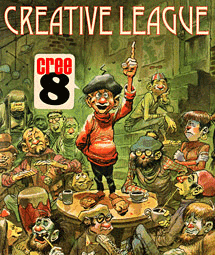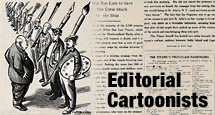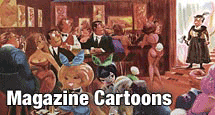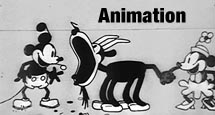This posting is a stub. You can contribute to this entry by providing information through the comments link at the bottom of this post. Please organize your information following the main category headers below….
Birth/Death
Birth: 17 November, 1907
Death: 12 September, 1979
Occupation/Title
Animator, Director, the first of Walt’s “Nine Old Men”
Bio Summary
Les Clark was born in Ogden, Utah, in 1907. He attended the elementary school there until his parents decided to move to Los Angeles. It was there that he graduated from Venice Highschool, 4 days before he began working for Walt Disney. He joined the ink and paint department in 1929 and had also started inbetweening. He won his first animation on Disney’s first Silly Symphonies “The Skeleton Dance.” Les became the key person in the development of Mickey Mouse. He started with Mickey’s debut film “Steamboat Willie”, then began creating his most memorable mickey scene’s such as Mickey in the Sorcerer’s apprentice. Les animated and directed on over 20 features which include “101 Dalmations,” “Dumbo,” Cinderella,” Alice in Wonderland,” “Peter Pan,” and many others as well as over 100 shorts. Les soon became director for television specials and educational films such as “Donald in Mathmagic Land,” and “Donald and the Wheel.” He retired from Disney in 1976 then later died of cancer in 1979.
Early Life/Family
Les Clark married Mirian Clark and had one biological daughter, Miriam Leslie Clarke Weible. They adopted Richard.
Education/Training
Went to elementary school in Twin Falls Idaho. Graduated from Venice Highschool in Los Angeles.
Career Outline
Clark entered animation at a pivotal time and participated in events that shaped not only Disney’s future but the history of the art form itself. When he arrived, the Alice series was winding down and a series starring a new character named Oswald the Lucky Rabbit was beginning. Ub Iwerks, who became Clark’s mentor, was the studio’s top animator, capable of turning out large numbers of cleverly animated drawings each day.
Before working at the Disney Studios, Walt Disney had complimented Les on the lettering he made for the menus on the mirrors at a candy store. Two years later in 1927, about to graduate from Venice High School, Clark got up the nerve to ask Walt for a job. “Bring some of your drawings in and let’s see what they look like,” he recalled Walt saying. At the Hyperion studio in the Silver Lake area east of Hollywood, Clark showed his samples, which he admitted were freehand copies of cartoons in College Humor, but Walt admired his “swift, deft” graphic line and hired him.
Clark graduated from high school on a Thursday and jubilantly reported to work the following Monday, February 23, 1927 though Walt warned him “it might just be a temporary job.” The “temporary” job lasted nearly half a century. By the time he retired in 1975, Les Clark was a senior animator and director, and the “longest continuously employed member of Walt Disney Productions.”
One of his earliest jobs was in-betweening for Ub Iwerks on Steamboat Willie. Les Clark’s debut as an animator came in the first Silly Symphony, The Skeleton Dance (delivered on May 10, 1929). He animated a scene of a skeleton playing the ribs of another skeleton like a xylophone.
Disney’s job offer changed Clark’s life. Throughout his lengthy career he repaid Walt with loyalty and a dogged striving to improve his work. In return, he gained a knowledge of the animation business from the ground up. During Clark’s first year at the studio, he happily toiled in the industry’s lowest entry-level positions: for his first six months he operated the animation camera, then spent a subsequent six months as an inker-painter.
Over the span of 48 years Les Clark animated and Directed a copious amount of films, as well as more than 100 short films. After serving as sequence director for “Sleeping Beauty” Les was asked by Walt to direct television specials and educational films. Les was the longest continuously employed member to Walt Disney. He was employed from February 23, 1927 to September 30, 1975.
Comments On Style
Influences
Trained by Ub Iwerks.
Personality
Les really did not have an art background, but because of his sheer determination and desire, he ended up being the principle animator for the iconic character, Mickey Mouse. His own personality was very similar to Mickey Mouse in fact. Les Clark was one of the more shy animators. He wasn’t one to boast about himself.
Anecdotes
Miscellaneous
Filmography
Animator
The Skeleton Dance 1929(Animator: “Xylophone scene)(uncredited)
The Barn Dance 1929(Animator: “Mickey Mouse”)
Frolicking Fish 1930(Animator)
The Goddess of Spring 1934(Animator)
The Dognapper 1934(Animator)
Two-Gun Mickey 1934(Animator)(uncredited)
The Band Concert 1935(Animator: “Mickey Mouse”)
Orphan’s Picnic 1936(Animator)
Mickey’s Grand Opera 1936(Animator)
The Country Cousin 1936(Animator)
Snow White and the Seven Dwarfs 1937(Animator: “Silly Song Sequence”)
Pinocchio 1940(Animator: “Pinocchio”)
Fantasia 1940(Animator)(segments “Nutcracker Suite”, “the Dewdrop Fairies” and “ the Sorcerer’s Apprentice”)
Dumbo 1941(Animator)
Der Fuehrer’s Face 1942(Animator)
The Three Caballeros 1944(Animator: “Train to Baia”)
Make Mine Music 1946(Animator)
Song of the South 1946(Animator: minor animals)
Fun and Fancy Free 1947(Directing Animator: “Lulubelle”)
Melody Time 1948(Directing Animator: “Bumble Boogie” sequence)
Plutopia 1951(Animator)
Alice in Wonderland 1951(Directing Animator)
Lady and the Tramp 1955(Directing Animator: “Lady” as puppy)
So Dear to My Heart 1949(Animator)
Peter Pan 1953(Directing Animator)
Disneyland 1954(Tv Series)(Animator: Tinker Bell”)(Director)(episode “ An Adventure in Color/Mathmagic Land”)
One Hundred and One Dalmations 1961(Character Animator)
The Mickey Mouse Anniversery Show 1968 (Animator:Mickey Mouse)
A Symposium on Popular Songs 1962(Animator)
Fantasia/2000 1999 (Animator)(segment “The Sorcerer’s Apprentice”)
Mickey Mouse Disco 1979 (Animator)
Director
You the Human Animal 1955(Director)
Paul Bunyan 1958(Director)
Sleeping Beauty 1959(Sequence Director)
Donald the Mathmagic Land 1959(Sequence Director)
Freewayphobia # 1 1965(Director)
Donald’s Fir Survival Plan 1965(Director)
Goofy’s Freeway Troubles 1965 (Director)
I’m No Fool with Electricity 1970 (Director)
VD Attack Plan 1973 (Director)
Man, Monsters and Mysteries 1973 (Director)
Choreographer:
You Were Meant for Me 1948(Choreographer)
Inbetween Artist:
Steamboat Willie 1928 (Inbetween Artist)
Honors
Winsor McCay Award 1992
Disney Legend 1989
Related Links
http://en.wikipedia.org/wiki/Les_Clark
http://www.www.imdb.com/Name?Clark, Les (I)
http://www.http://www.disneylandtoday.com/Legends/lesclark.htm
Bibliographic References
Canemaker, John. (2001). Walt Disney’s Nine Old Men and the Art of Animation. New York, NY: Disney Editions. ISBN 0-7868-6496-6
Contributors To This Listing
Josh Heisie
To make additions or corrections to this listing, please click on COMMENTS below…





























